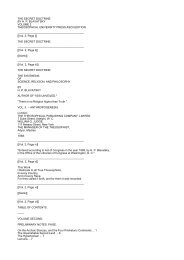Create successful ePaper yourself
Turn your PDF publications into a flip-book with our unique Google optimized e-Paper software.
Plates XXXIII and XXXIV.<br />
2. Adding from <strong>the</strong> Nebseni papyrus: as kua xenen-a uaa pen aa em Se-Hetep.<br />
3. Adding from <strong>the</strong> Nebseni papyrus: renp-th renp-th xen-na em se-s er sper-a er nut-s xent-a er Hetep-sen entet.<br />
4. I.e., Horus and Set.]<br />
{p. 364}<br />
on a pylon-shaped pedestal, before which are an altar and a god. Three ovals.[1] The legend reads un em<br />
hetep sexet nifu er fent, "Being at peace in <strong>the</strong> Field [<strong>of</strong> Peace], and having air for <strong>the</strong> nostrils."<br />
(b.) Ani reaping wheat, with <strong>the</strong> words asex Ausar, "Osiris reaps"; guiding <strong>the</strong> oxen treading out <strong>the</strong><br />
corn; standing with hands and holding <strong>the</strong> kherp sceptre, and kneeling before two vessels <strong>of</strong> red barley<br />
and wheat. The hieroglyphics seem to mean, "<strong>the</strong> food <strong>of</strong> <strong>the</strong> shining ones." Three ovals.[2]<br />
(c.) Ani ploughing[3] with oxen in a part <strong>of</strong> <strong>the</strong> Fields <strong>of</strong> Peace called "Sekhet-aanre"; with <strong>the</strong> word<br />
sekau, to plough. The two lines <strong>of</strong> hieroglyphics read:--<br />
re en hete'et atru 1000 em au-f an t'et usex-f an un remu neb am-f an hefau nebt am-f.<br />
Chapter <strong>of</strong> <strong>the</strong> River-horse. The river is one thousand [cubits] in its length. Not can be told its width. Not<br />
exist fishes any in it, not [exist] serpents any in it.<br />
[1. In <strong>the</strong> Nebseni papyrus <strong>the</strong>y are called Qetqetmu, Hetepmu, and Urmu.<br />
2. Instead <strong>of</strong> three, <strong>the</strong> Nebseni papyrus has four ovals, which are called Hetep, An (?), Uakhakha, and Neb-taui.<br />
3 In <strong>the</strong> Turin papyrus, published by Lepsius, <strong>the</strong> ploughing, sowing, reaping and treading out <strong>the</strong> corn are all shown in<br />
one division, and <strong>the</strong> deceased stands in adoration before "Hapi, <strong>the</strong> fa<strong>the</strong>r <strong>of</strong> <strong>the</strong> gods."<br />
In <strong>the</strong> papyrus <strong>of</strong> Nebseni <strong>the</strong> deceased adores <strong>the</strong> company <strong>of</strong> <strong>the</strong> gods who live in <strong>the</strong> Field <strong>of</strong> Hetep, saying: "Hail to<br />
you, O ye lords <strong>of</strong> kas, I have come in peace into your fields to receive tchefau food. Grant ye that I may come to <strong>the</strong> great<br />
god daily, and that I may have sepulchral meals, and that my ka may be supplied with <strong>the</strong> meat and drink <strong>of</strong>fered to <strong>the</strong><br />
dead. May Osiris and <strong>the</strong> company <strong>of</strong> <strong>the</strong> gods, who dwell in <strong>the</strong> Field <strong>of</strong> Hetep, give a royal oblation, may <strong>the</strong>y {footnote<br />
p. 365} grant meat and drink and all good things, and bandages and incense every day. And may I sit down at <strong>the</strong> table [<strong>of</strong><br />
<strong>the</strong> god] daily to receive bread <strong>of</strong> his bread, and cakes, and wine, and milk, and tchefau food; and may I follow in <strong>the</strong> train<br />
<strong>of</strong> <strong>the</strong> god when he maketh his appearance in his festivals in Res-tau." (For <strong>the</strong> text see Naville, Todtenbuch, Bd. I., Bl.<br />
123.)]<br />
{p. 365}<br />
(d.) A boat bearing a flight <strong>of</strong> steps and floating on a stream;[1] above is <strong>the</strong> legend tehefau,[2] (?)~ A<br />
boat <strong>of</strong> eight oars, each end shaped like a serpent's head, bearing a flight <strong>of</strong> steps; at <strong>the</strong> stern is written<br />
and at <strong>the</strong> bows meter am Un-nefer, "<strong>the</strong> god <strong>the</strong>rein is Un-nefer." The stream which flows on <strong>the</strong> convex<br />
side <strong>of</strong> <strong>the</strong> small island is called ashet pet, "flood (?) <strong>of</strong> [heaven]." On <strong>the</strong> o<strong>the</strong>r island is placed a flight<br />
<strong>of</strong> steps, by <strong>the</strong> side <strong>of</strong> which is written The space to <strong>the</strong> left represents <strong>the</strong> abode <strong>of</strong> <strong>the</strong> blessed dead,<br />
and is described as:--<br />
duset xu au-sen meh sexef at meh xemt an saku aqeru asexet-sen<br />
The seat <strong>of</strong> <strong>the</strong> shining ones. Their length is cubits seven <strong>the</strong> wheat cubits three <strong>the</strong> blessed dead who are<br />
perfected <strong>the</strong>y reap [it].<br />
[1. In <strong>the</strong> Turin papyrus this boat is called uda en Ra-Heru-xuti xeft t'a-f er Sexet Aanre: <strong>the</strong> boat <strong>of</strong> Ra-Harmachis when<br />
http://www.sacred-texts.com/egy/ebod/ebod39.htm (4 <strong>of</strong> 5) [8/10/2001 11:29:23 AM]

















